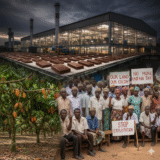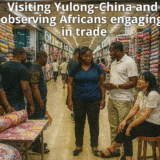Lessons from Yùlóng Hé
We had arrived at the bridge on a Didi Taxi from our hotel, and the sight that greeted us—of the Yùlóng Hé (Yulong River) and the many activities ongoing—was truly captivating. This wasn’t just a picturesque natural wonder; it was an active, commercial ecosystem set against the backdrop of magnificent, emerald karst mountains, shaped as if an oval were cut into two and placed on the ground to resemble a small letter ‘n’.
On the bridge, tourists were posing to catch that poster-perfect picture of themselves, the river, and the surrounding scenery, battling an uphill task: ensuring their frame was not photobombed by the stream of adventurers.
Down below, however, a more profound lesson was immediately visible: mechanisation was at work. A creative lift was constantly churning, removing the lightweight bamboo rafts from the river and stacking them onto waiting open-back trailers, on their way to be delivered to the next starting point upstream. This single, organised process signalled that this natural treasure was, in fact, a tightly managed, capital-intensive business.
All over the river, countless bamboo rafts and their tourist occupiers were being piloted downriver by standing canoe men with their long bamboo paddles. The sights were a beauty to the eyes. After navigating the typical language barriers to find the ticket office and securing our passes, we were helped onto our wooden chairs.
The amazing journey started, steered by a paddler who, despite speaking no English and likely lacking the education for an alternative career, radiated happiness. This contentment was clearly derived from earning a decent, sustainable pay for his day’s work. The river itself, gently flowing for hundreds of years, was spotlessly clean—free of floating dead wood, household rubbish, or any nauseating substance. The banks were beautifully vegetated, offering serenity and moments of reflection.
It was this seamless, commercial operation, hidden beneath the surface of natural glory and courteous service, that revealed its greatest lesson: the power of organisation.
The Yulong Model: Transforming Chaos into a Gold Mine
Prior to its transformation, the Yulong River was not the pristine tourist magnet we see today. For centuries, the river was an unregulated, multi-use waterway, serving as a lifeline for the local population. Its uses included subsistence fishing, individual traders plying their wares, and villagers simply transporting goods.
Crucially, in the decades leading up to the major tourism boom (late 1990s/early 2000s), the river was a classic case of the “Tragedy of the Commons.” Without unified management, it suffered from pollution, with people throwing their garbage into it, resulting in floating debris and environmental degradation. The experience was chaotic and lacked any guaranteed safety or service standard for visitors.
The transformation began when purposeful leadership made a decisive intervention. The vision was to replace the scattered, low-value activities with a single, highly structured, high-value tourism enterprise. This required clearing the old, polluting uses and imposing an organisation that benefited the environment and the former participants.
My personal observation of the newly organised system reveals four key pillars that replaced the previous chaos:
1. Strategic and Purposeful Investment in Core Infrastructure
The first step in transforming a chaotic market is to inject purposeful, large-scale capital that individual actors cannot provide. This capital injection is non-negotiable and provides the foundation for the new, sustainable market.
- The Yulong Solution: A mandated entity or government body invested heavily in:
- Environmental Remediation: The river was cleaned and kept clean. The beautiful, clean banks—vegetated where urbanisation hasn’t touched—are evidence of sustained maintenance.
- Operational Efficiency: The installation of the creative lift and trailer system to move rafts upstream drastically reduces operational costs and turnaround time. This mechanisation allows the paddler to focus solely on the profitable task of piloting tourists downriver.
- Tourist Facilitation: The provision of at least six artificial rapids enhances the tourist experience, while supporting infrastructure like ticket offices and clean public restrooms (toilets) improves convenience.
When markets are disorganised, they are subject to the Tragedy of the Commons. In the Yulong case, a single entity was empowered to internalise the external cost of pollution and congestion, turning the environment into a protected asset that yields profit for all.
2. Formalisation and Standardisation of Service Delivery
A disorganised market thrives on arbitrariness in pricing, quality, and safety. The Yulong Model replaced this with mandatory formalisation and training, ensuring service quality reached an international standard.
- The Yulong Solution:
- Mandatory Registration: “If you want to earn a living on the river, you have to be registered, undergo basic safety courses and courtesy.” This immediately brings participants into a structured system.
- Safety & Certification: Rafts must be registered and “certified safe at all times.” I was drawn to the simple but crucial step of putting on a visible red life jacket—a non-negotiable safety procedure.
- Quality Control: Despite the language barrier, the paddler’s conduct was friendly and professional, waving and exchanging greetings with other tourists. This confirms that standardisation of courteous conduct can be enforced successfully even in informal or low-skill labour.
3. Centralised Revenue Collection and Fair Disbursement
The most critical step in taming a chaotic, revenue-leakage-prone market is to establish a single, transparent point of sale.
- The Yulong Solution: The government or enterprise established centralised ticketing using passports for identification.
- The Ticketing System: Fares are collected centrally at the ticket office before access is granted. At the river gate, checks are strictly carried out to assure payment and assign the paddler to the team. This singular point of sale prevents individual paddlers from undercutting prices or overcharging.
- Fair Disbursement: The ticket price (¥200 per raft) is managed centrally, and a portion is guaranteed to the paddler. The visible happiness of the paddler, earning a “decent pay,” confirms that the disbursement mechanism works for the workers, providing them with a higher, reliable wage than the previous unregulated market.
The Nigerian Question
The question that follows this experience is this: Why was Youngsho successful in this, and the attempt to do similar with FMLM failed in Nigeria? The Yulong River is a tangible, living example that a highly profitable, universally appreciated, and sustainable market can be built from chaotic beginnings.
The ultimate benefit of this model is that “everyone is happier”: the government earns sustainable revenue, the environment is protected, tourists pay a fair price for a world-class experience, and the local worker earns a decent, dignified wage. Such is the power of visionary, non-self-serving leadership in transforming societies and lives.



